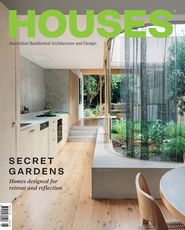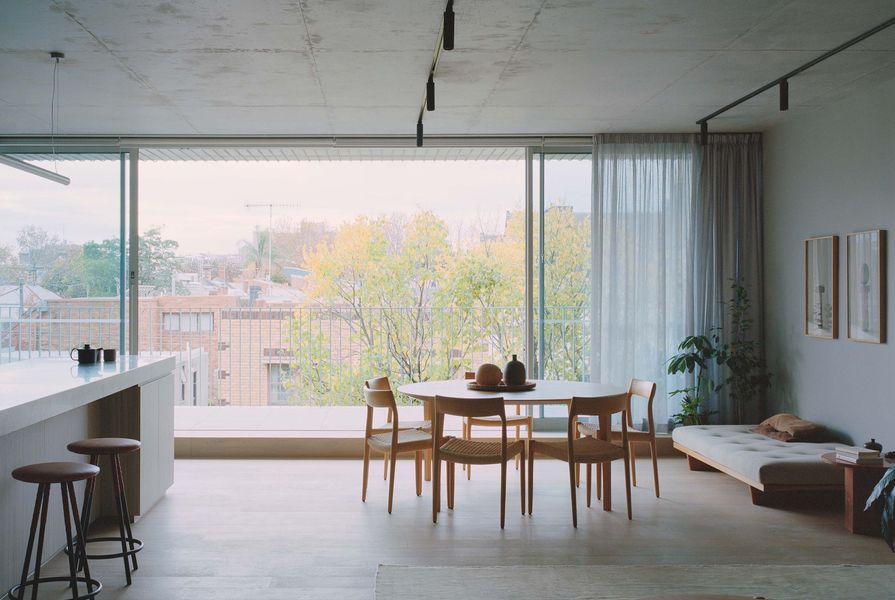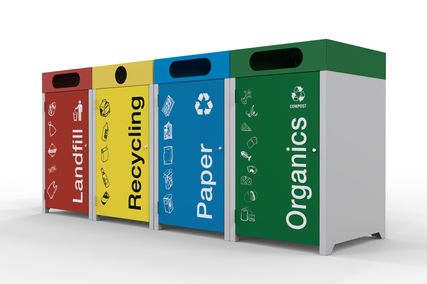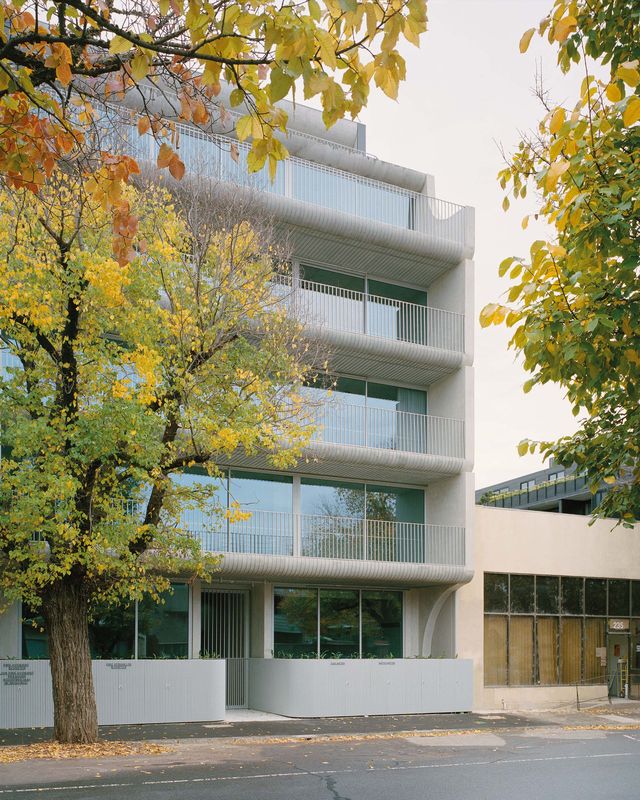Edition Office’s projects commence with a process of abstraction. Contextual and conceptual relationships are distilled into a discrete set of design ideas. These are represented in the form of models and diagrams, which then serve as touchstones during the long, messy and contradictory process of producing a building. This process serves the practice well – it is evident in the conceptual rigour apparent in all its projects and in the legibility of each concept or set of key relationships at various scales, from grand formal gestures to detailing.
Napier Street Apartments – Edition Office’s first multiresidential project, located in leafy Fitzroy, Melbourne – is no exception, presenting a distinctive formal language to the street that is intensified throughout its internal common areas and apartments. Mute and restrained, the Napier Street facade is a sculptural composition of raw concrete and curving steel. It acknowledges the surrounding Victorian terraces’ curved flanking walls as well as their metal lacework, here reimagined in the form of fine steel plates that follow the arc of the scalloped balcony soffits. Care has been taken to articulate each floor of the building as a separate home via notches in the side walls at each soffit line, giving the impression of distinct residences, vertically stacked. Behind the generously sized east-facing glazing, soft furnishings and coloured joinery elements hint at the domesticity within. From the street, the project can be read as a sculptural and contextually responsive shell within which a locus of colour and domestic intensity is nested.
The interior offers a warm and textural contrast to the building’s industrial shell. Artworks (L–R): Diana Miller, Matt Arbuckle, Zoe Croggon. Sculpture: Kate Tucker.
Image: Rory Gardiner
Internally, these relationships are further explored and intensified. The journey from entry to apartment is via a cool, textural interplay of concrete, metal plate and perforated metal sheets – all in a similar milky grey – punctured with pools of sunlight entering via the central atriums. Inside the east-facing apartment on the second floor, an additional level of texture is revealed: raw concrete floors become lime-washed timber and the concrete walls are dressed in soft grey linen curtains. At the centre of the space lies a detailed and deeply saturated green joinery unit that appears all the more vibrant against its neutral backdrop. This apartment, like all of those on the east side of the building, takes up the entire width of the floorplate and the generous glazing provides dazzling morning light through leafy treetops against a complementary backdrop of red-bricked neighbours. The central courtyards enable this generous vista by providing light and air to the bedrooms nestled at the rear of the apartment. The result is a sunlit, textural and generous living space that balances the robust, almost industrial quality of its concrete structure with soft furnishings and detailed, richly coloured joinery.
Downstairs, the two-level, ground-floor apartments provide another take on a Fitzroy terrace trope: a light court at street level. Precedents for this arrangement can be found in some terraces on neighbouring Gore Street, where light courts are introduced at ground level to illuminate rooms that have effectively been built partially underground, due to the rapidly sloping terrain from west to east. At 231 Napier Street, light courts are introduced at the Napier Street interface to the east, enabling the ground-floor apartments’ lower-ground level to have access to light without the noise and exposure typical of the street-level apartment. The arrangement is also very spatially dramatic – on entering the apartments at ground level, the visitor moves downstairs into a sub-ground living space with high-level views across the leafy street trees and a wash of light from above. The space is generous and feels private, cool and quiet, with a fern-filled outdoor terrace at lower-ground level that offers a spot for a quiet morning coffee or an evening whisky under the stars. Again, the bedrooms are serviced by light courts to the rear, and the fitout reinterprets the relationship of neutral shell and vivid joinery to suit the new spatial arrangement.
In the kitchen, cabinetry in saturated hues of green adds intensity to an otherwise subdued palette.
Image: Rory Gardiner
Designed prior to the COVID-19 outbreak, this thoughtful contribution to multiresidential development in Fitzroy nevertheless seems appropriate for our new era: common spaces and apartments alike are robust in their material palette, well-ventilated and light-filled yet simultaneously private. Both the Napier Street facade and the rear laneway facade have been carefully considered to provide light, views and appropriate screening to apartments, with elegant materiality and detailing that both benefits the residences and contributes to the streetscape. The sculptural exterior appears reassuringly protective of the living spaces within, which have doubtless seen more intense activity than was anticipated over the past two years of lockdowns, while the concrete, oak and linen fitout is calming and enduring – the perfect refuge during years beset by fires, viruses and violent protests. As we approach 2022 and commence what we can only hope is COVID normality, the Napier Street Apartments provide a sanctuary for their residents as they hope (or plan) for calmer years ahead.
Products and materials
- Roofing
- Lysaght Klip-Lok roof decking in Zincalume.
- External walls
- AFS Logicwall fibre-cement formwork; Rockcote Santini render; Dulux paint in ‘Edition Office Grey’; Metroll wall panelling in ‘Monument’.
- Internal wsalls
- Dulux paint in ‘Edition Office Grey’; Ceramica Vogue tiles from Classic Ceramics.
- Windows
- Architectural Window Systems frames in Dulux Duratec Zeus ‘Silver Grey’; Viridian Lightbridge double glazing.
- Doors
- Madinoz door pulls in Dulux Duratec Zeus ‘Silver Grey’; Schlage stainless steel door levers; door latches from Bellevue Architectural.
- Flooring
- Hallmarc collection engineered timber flooring in ‘White Wash’.
- Lighting
- Sphera; Glo Ball by Flos.
- Kitchen
- Fisher and Paykel appliances; G-Lux benchtops in ‘Amalfi’ and ‘Lantern Green’; American oak veneer and 2-pac cabinetry by In Detail in Dulux ‘Depth Charge,’ ‘Edition Office Grey’ and Laminex ‘Avignon Walnut’.
- Bathroom
- Tapware from Phoenix Tapware; fittings from Caroma and Kohler; Classic Ceramics Vogue tiles in ‘Turchese’ and ‘Vogue Lilla’; G-Lux benchtop in ‘Lantern Green’; 2-pac cabinetry by In Detail in Dulux ‘Depth Charge’.
- External elements
- Perforated steel in Dulux Duratec Zeus ‘Silver Grey’ and balustrades in hot dip galvanized steel by Syndicate Engineering.
Credits
- Project
- 231 Napier Street by Edition Office for Milieu
- Architect
- Edition Office
Vic, Australia
- Project Team
- Kim Bridgland, Aaron Roberts, Jonathan Brener, Laura Tindall, Kate Finning
- Developer
- Milieu Property
Melbourne, Vic, Australia
- Consultants
-
Builder
Arc3
ESD consultant GIW
Engineer Stantec
Landscaping Etched Projects
- Aboriginal Nation
- 231 Napier Street is built on the land of the Wurundjeri Woi Wurrung.
- Site Details
-
Location
Melbourne,
Vic,
Australia
Site type Urban
Site area 394 m2
Building area 188 m2
- Project Details
-
Status
Built
Design, documentation 18 months
Construction 18 months
Category Residential
Type Apartments
Source

Project
Published online: 4 Mar 2022
Words:
Marnie Morieson
Images:
Edition Office,
Rory Gardiner
Issue
Houses, February 2022

























